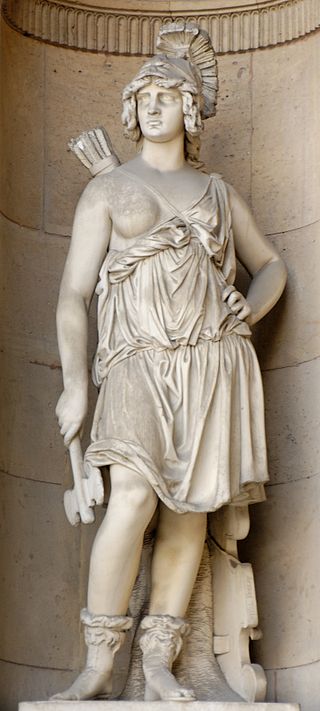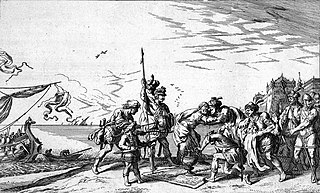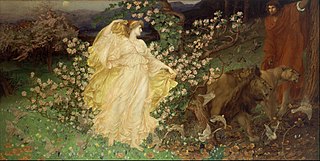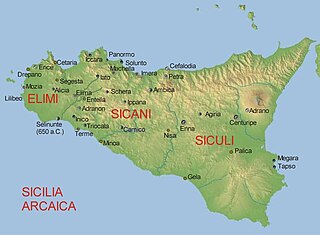
In Greco-Roman mythology, Aeneas was a Trojan hero, the son of the Trojan prince Anchises and the Greek goddess Aphrodite. His father was a first cousin of King Priam of Troy, making Aeneas a second cousin to Priam's children. He is a minor character in Greek mythology and is mentioned in Homer's Iliad. Aeneas receives full treatment in Roman mythology, most extensively in Virgil's Aeneid, where he is cast as an ancestor of Romulus and Remus. He became the first true hero of Rome. Snorri Sturluson identifies him with the Norse god Víðarr of the Æsir.

The Judgement of Paris is a story from Greek mythology, which was one of the events that led up to the Trojan War, and in later versions to the foundation of Rome.

In Greek mythology, Scylla is a legendary monster who lives on one side of a narrow channel of water, opposite her counterpart Charybdis. The two sides of the strait are within an arrow's range of each other—so close that sailors attempting to avoid Charybdis would pass dangerously close to Scylla and vice versa.

The Trojan War was a legendary conflict in Greek mythology that took place around the 12th or 13th century BCE. The war was waged by the Achaeans (Greeks) against the city of Troy after Paris of Troy took Helen from her husband Menelaus, king of Sparta. The war is one of the most important events in Greek mythology, and it has been narrated through many works of Greek literature, most notably Homer's Iliad. The core of the Iliad describes a period of four days and two nights in the tenth year of the decade-long siege of Troy; the Odyssey describes the journey home of Odysseus, one of the war's heroes. Other parts of the war are described in a cycle of epic poems, which have survived through fragments. Episodes from the war provided material for Greek tragedy and other works of Greek literature, and for Roman poets including Virgil and Ovid.

Venus is a Roman goddess, whose functions encompass love, beauty, desire, sex, fertility, prosperity, and victory. In Roman mythology, she was the ancestor of the Roman people through her son, Aeneas, who survived the fall of Troy and fled to Italy. Julius Caesar claimed her as his ancestor. Venus was central to many religious festivals, and was revered in Roman religion under numerous cult titles.

Segesta was one of the major cities of the Elymians, one of the three indigenous peoples of Sicily. The other major cities of the Elymians were Eryx and Entella. It is located in the northwestern part of Sicily in Italy, near the modern commune of Calatafimi-Segesta in the province of Trapani. The hellenization of Segesta happened very early and had a profound effect on its people.

Helen, also known as Helen of Troy, in Latin as Helena, beautiful Helen, Helen of Argos, or Helen of Sparta, was a figure in Greek mythology said to have been the most beautiful woman in the world. She was believed to have been the daughter of Zeus and Leda, and was the sister of Clytemnestra, Castor and Pollux, Philonoe, Phoebe and Timandra. She was married to King Menelaus of Sparta "who became by her the father of Hermione, and, according to others, of Nicostratus also." Her abduction by Paris of Troy was the most immediate cause of the Trojan War.

In Greek mythology, Teucer, also Teucrus, Teucros or Teucris, was the son of King Telamon of Salamis Island and his second wife Hesione, daughter of King Laomedon of Troy. He fought alongside his half-brother, Ajax, in the Trojan War and is the legendary founder of the city of Salamis on Cyprus. Through his mother, Teucer was the nephew of King Priam of Troy and the cousin of Hector and Paris—all of whom he fought against in the Trojan War.

In Greek and Roman mythology, a harpy is a half-human and half-bird, often believed to be a personification of storm winds. They feature in Homeric poems.

Penthesilea was an Amazonian queen in Greek mythology, the daughter of Ares and Otrera and the sister of Hippolyta, Antiope, and Melanippe. She assisted Troy in the Trojan War, during which she was killed by Achilles or Neoptolemus. The asteroid 271 Penthesilea, discovered in 1887, was named in her honor.

In Greek mythology, Anius was a king of Delos and priest of Apollo.
Elymus was the supposed Trojan ancestor of the Elymians (Ἔλυμοι), an indigenous people of Sicily, in Greek and Roman legend.

In Greek and Roman mythology, Anchises was a member of the royal family of Troy. He was said to have been the son of King Capys of Dardania and Themiste, daughter of Ilus, who was son of Tros. He is most famous as the father of Aeneas and for his treatment in Virgil's Aeneid. Anchises' brother was Acoetes, father of the priest Laocoön.

In Roman mythology, Acestes or Egestes was the son of the Sicilian river-god Crinisus by a Dardanian or Trojan woman named Egesta or Segesta.

Éntella, was an ancient city in the interior of Sicily, situated on the left bank of the river Hypsas, and nearly midway between the two seas, being about 40 km from the mouth of the Hypsas, and much about the same distance from the north coast of the island, at the Gulf of Castellamare.

Entellus was a Trojan or Sicilian hero from whom the town of Entella in Sicily was believed to have received its name. He was a friend of the Trojan king Acestes. A boxing match between Entellus and an arrogant younger boxer, Dares, is described in the fifth book of Virgil's Aeneid.

Eryx was an ancient city and a mountain of Magna Graecia in the west of Sicily, about 10 km from Drepana, and 3 km from the sea-coast. It was located at the site of modern Erice.
In Greek mythology, Aethilla or Aethylla was Trojan princess as a daughter of King Laomedon and sister of Priam, Lampus, Hicetaon, Clytius, Hesione, Cilla, Astyoche, Proclia, Medesicaste and Clytodora.

The Segestan thermal baths are hydrothermal springs located in Sicily, between Alcamo and Castellammare del Golfo, in the province of Trapani.

In Greek and Roman mythology, Creusa is the wife of Aeneas, and the mother of Ascanius. According to Apollodorus, she is the daughter of Priam and Hecuba. A number of sources describe her presence during the sack of Troy, with her often fleeing the city alongside her husband. In Virgil's Aeneid, Creusa is lost in the confusion while their family is trying to escape, leading Aeneas to turn back to look for her; there he is met with her shade, which foretells of his future journey to Hesperia, where he is told he will marry a different woman.


















